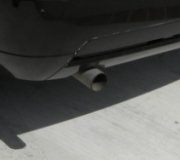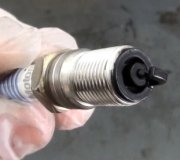Ok,
Here is info on backfiring through exhaust.
Step 1 - Engine timing is to be set at a specific degree in relation to the crankshaft of the engine. If this timing becomes mis-aligned it can cause low power, poor gas mileage, engine detonation (pinging) and backfiring. To check the engine timing locate the number one cylinder of the engine. This number one cylinder will be the forward most cylinder of the engine. On straight 4 and 6 cylinders engines it is pretty obvious, but on "V" style of engines like the V8 it is a little more tricky. The cylinders heads on every "V" style of engine are offset from one to the other. One cylinder head is more forward than the other. The most forward cylinder head is the side of the engine where the number one cylinder is located. The forward most cylinder is the number one cylinder.
Next, locate the crankshaft timing marks, most engines timing marks are at the front of the engine on the harmonic balancer. Near the balancer there is a small pointer or scale to align the balancer mark to. When the engine is running this gauge or pointer should align with the mark on the balancer. When the engine is running the timing light will strobe and illuminate the balancer mark as it spins. To adjust the timing loosen the distributor and turn slightly one way or the other to achieve the desired setting. Once an adjustment has been made re-tighten the distributor hold down bolt or bolts. Some engine's timing marks are located at the rear of the engine on the flywheel. Before you begin start and run the engine until warmed to operating temperature. Connect the positive and negative leads of a timing light to the battery. Observe the timing tag either on the engine or engine compartment for the timing specification and procedure. If the specification and instruction cannot be found consult a car repair manual.
Step 2 - Some engine exhaust systems have an air injection system designed to help dilute the exhaust gases. This added air is only in operation during power mode. If the air injection check valve or sometime referred to as a "gulp valve" fails it can allow extra air into the exhaust system causing system internal and external backfiring. To check your systems valve remove it and check air flow. Air should only travel one direction hence the name: "check valve". If air travels both directions the valve has failed and needs replacement.
Step 3 - The exhaust system of your car is designed to remove poisonous gases from the engine to the rear of the vehicle. If something in the ignition system is intermittently failing it can cause unspent fuel inside the exhaust system to ignite when the ignition system returns to operation.
Step 4 - Small leaks in the exhaust system can suck in cool air during deceleration causing a popping or backfiring in the exhaust system as well. Inspect your exhaust system for any leaks that can cause this such as broken welds or rust holes.
When was last tune up Cap. Rotors and Plugs. A corroded cap and rotor can also cause your problem.
.
Saturday, August 28th, 2010 AT 7:38 PM



